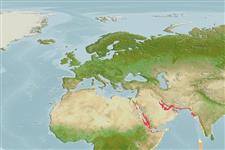Teleostei (teleosts) >
Blenniiformes (Blennies) >
Tripterygiidae (Triplefin blennies) > Tripterygiinae
Etymology: Enneapterygius: Greek, ennea = nine times + Greek, pterygion = little fin (Ref. 45335).
Eponymy: Prince Alexander (also Iskinder and Eskander) Desta (1934–1974) was Admiral of the former Ethiopian Imperial Navy; he was one of 60 imperial officials who were executed when the Derg took over the country (where this blenny occurs in the Red Sea). (Ref. 128868), visit book page.
Environment: milieu / climate zone / depth range / distribution range
Ecology
Marine; demersal; depth range 2 - 12 m (Ref. 88983). Tropical
Western Indian Ocean: Red Sea.
Size / Weight / Age
Maturity: Lm ? range ? - ? cm
Max length : 2.1 cm SL male/unsexed; (Ref. 88983)
Short description
Identification keys | Morphology | Morphometrics
Dorsal spines (total): 14 - 17; Dorsal soft rays (total): 8 - 9; Anal spines: 1; Anal soft rays: 15 - 17; Vertebrae: 32 - 33. Diagnosis: Dorsal fins III + XI-XIII + 8-9 (usually III + XI-XII +8- 9); anal fin I, 15-17 (usually 16); pectoral fin 15: 3+5+7. LL, pored scales8-12; notched scales 21-23, starting at 2 scale rows below the end of the pored series; total lateral scales 28-29; transverse scales 2/5; nape with scales, abdomen scaleless, single row of scales at base of pectoral fin. Body depth 4.5-5.2 in SL. Vertebrae 10 + 21-22. Dentary pores 3 + 2 + 3; head 3.1-3.4 in SL; eye 2.5-3.0 in head length; orbital cirrus minute, rounded flap about half the diameter of pupil, distally serrated margin; supratemporal sensory canal crescent-shaped; first dorsal fin same height in males and females, about 60% of the second. Key features are: body bars brown; caudal peduncle spots 2 black, the lower one smaller; five black blotches on anal fin, anteriormost largest and darkest; face pink with brown bar below eye; first dorsal fin crimson in males (Ref. 57774, 88983).
Adults inhabit bays and lagoons rich in corals, 2-12 m; usually found in crevices near Porites or on the vertical face of this coral (Ref. 88983). Eggs are hemispherical and covered with numerous sticky threads that anchor them in the algae on the nesting sites (Ref. 240). Larvae are planktonic which occur primarily in shallow, nearshore waters (Ref. 94114).
Life cycle and mating behavior
Maturity | Reproduction | Spawning | Eggs | Fecundity | Larvae
Holleman, W. and S.V. Bogorodsky, 2012. A review of the blennioid fish family Tripterygiidae (Perciformes) in the Red Sea, with description of Enneapterygius qirmiz, and reinstatement of Enneapterygius altipinnis Clark, 1980. Zootaxa 3152:36-60. (Ref. 88983)
IUCN Red List Status (Ref. 130435: Version 2024-1)
Threat to humans
Harmless
Human uses
Fisheries: of no interest
Tools
Special reports
Download XML
Internet sources
Estimates based on models
Preferred temperature (Ref.
123201): 24.8 - 29.3, mean 28.2 °C (based on 202 cells).
Phylogenetic diversity index (Ref.
82804): PD
50 = 0.5000 [Uniqueness, from 0.5 = low to 2.0 = high].
Bayesian length-weight: a=0.00794 (0.00346 - 0.01822), b=3.08 (2.88 - 3.28), in cm total length, based on LWR estimates for this (Sub)family-body shape (Ref.
93245).
Trophic level (Ref.
69278): 3.0 ±0.3 se; based on size and trophs of closest relatives
Resilience (Ref.
120179): High, minimum population doubling time less than 15 months (Preliminary K or Fecundity.).
Fishing Vulnerability (Ref.
59153): Low vulnerability (10 of 100).
